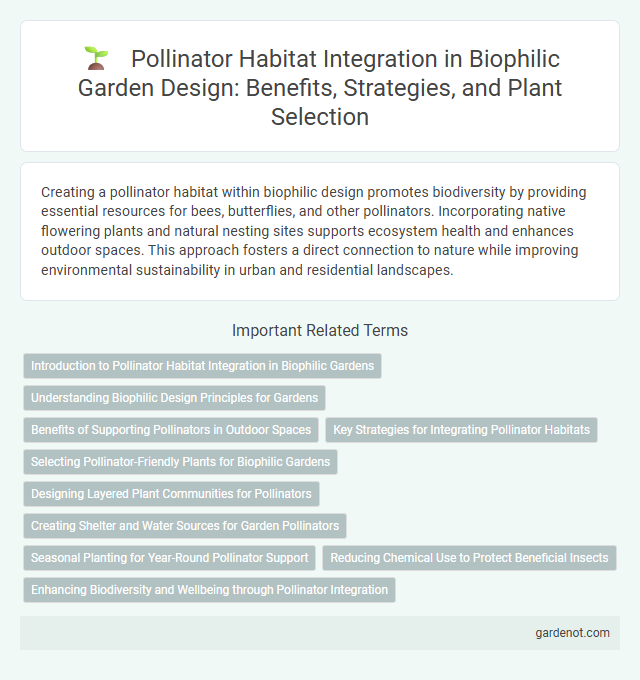Creating a pollinator habitat within biophilic design promotes biodiversity by providing essential resources for bees, butterflies, and other pollinators. Incorporating native flowering plants and natural nesting sites supports ecosystem health and enhances outdoor spaces. This approach fosters a direct connection to nature while improving environmental sustainability in urban and residential landscapes.
Introduction to Pollinator Habitat Integration in Biophilic Gardens
Pollinator habitat integration in biophilic gardens enhances biodiversity by providing essential resources such as nectar, pollen, and nesting sites for bees, butterflies, and other pollinators. Incorporating native flowering plants and structural elements like bee hotels supports pollination services critical to ecosystem health and food production. Strategic design promotes habitat connectivity, fostering resilient urban environments that benefit both pollinators and human well-being.
Understanding Biophilic Design Principles for Gardens
Pollinator habitats in biophilic design emphasize native plant species that provide nectar and pollen, supporting essential pollinator populations like bees, butterflies, and hummingbirds. Incorporating diverse flowering plants with varied bloom times ensures sustained food sources, enhancing ecosystem resilience and garden biodiversity. Designing these habitats around natural patterns promotes ecological balance, improves pollination rates, and strengthens local environmental health.
Benefits of Supporting Pollinators in Outdoor Spaces
Creating pollinator habitats in outdoor spaces enhances biodiversity and supports essential ecosystem services like crop pollination and plant reproduction. Native flowering plants and nectar sources provide vital nutrition for bees, butterflies, and other pollinators, promoting their population growth and resilience. Supporting pollinators also improves garden health, increases fruit and seed yield, and contributes to climate change mitigation through strengthened natural habitats.
Key Strategies for Integrating Pollinator Habitats
Incorporating native flowering plants and creating continuous bloom cycles are key strategies for establishing effective pollinator habitats within biophilic design. Designing layered vegetation structures with diverse plant species supports varied pollinator species at different life stages and enhances ecological resilience. Integrating water sources and nesting sites further optimizes habitat functionality and encourages sustainable pollinator populations in built environments.
Selecting Pollinator-Friendly Plants for Biophilic Gardens
Selecting pollinator-friendly plants for biophilic gardens enhances biodiversity by providing essential nectar and pollen sources for bees, butterflies, and other pollinators. Native flowering plants with staggered bloom times ensure year-round habitat and food supply, supporting ecosystem resilience. Incorporating a diverse mix of herbs, shrubs, and wildflowers tailored to the local climate maximizes pollinator attraction and promotes garden health.
Designing Layered Plant Communities for Pollinators
Designing layered plant communities for pollinators enhances biodiversity by mimicking natural ecosystems with diverse vegetation strata, including ground covers, shrubs, and canopy trees. This approach supports various pollinator species by providing continuous bloom cycles and diverse foraging habitats, crucial for bees, butterflies, and hummingbirds. Incorporating native plants with staggered flowering times optimizes nectar and pollen availability, fostering resilient and productive pollinator habitats within biophilic design frameworks.
Creating Shelter and Water Sources for Garden Pollinators
Creating shelter and water sources in biophilic garden design supports pollinator health by providing essential habitats for bees, butterflies, and other beneficial insects. Incorporating native plants with dense foliage, hollow stems, and ground cover offers natural refuge, while shallow water features like birdbaths with stones enable safe hydration. These elements enhance biodiversity, promote pollination efficiency, and sustain ecosystems within urban or residential landscapes.
Seasonal Planting for Year-Round Pollinator Support
Seasonal planting enhances pollinator habitats by providing continuous sources of nectar and pollen throughout the year, supporting diverse species such as bees, butterflies, and hummingbirds. Incorporating native plants like goldenrod in fall, milkweed in summer, and crocus in early spring sustains pollinator populations during critical periods. This strategy fosters biodiversity, improves ecosystem resilience, and promotes agricultural productivity through effective pollination services.
Reducing Chemical Use to Protect Beneficial Insects
Reducing chemical use in biophilic design supports the protection of pollinator habitats by minimizing exposure to harmful pesticides that threaten bees, butterflies, and other beneficial insects. Implementing organic gardening practices and integrated pest management helps maintain healthy ecosystems essential for pollination services. Preserving native plants within these habitats further enhances resilience against pests without reliance on synthetic chemicals.
Enhancing Biodiversity and Wellbeing through Pollinator Integration
Integrating pollinator habitats within biophilic design significantly enhances urban biodiversity by providing essential resources for bees, butterflies, and other pollinating species. This natural influx supports ecological balance and strengthens plant reproduction cycles, leading to more resilient green spaces. The presence of diverse pollinators also contributes to improved human wellbeing by fostering sensory connection to nature and promoting mental restoration.
Pollinator habitat Infographic

 gardenot.com
gardenot.com